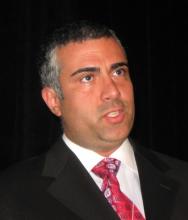SAN FRANCISCO – The outcomes of patients following a subarachnoid hemorrhage may derive in part from whether they received transfusions of red blood cells, had anemia, or were taking beta blockers beforehand, the findings from three new studies suggest.
Anemia is common after subarachnoid hemorrhage and has been associated with increased morbidity and mortality, worse functional outcomes, increased risk of delayed ischemic complications, and brain tissue hypoxia. Although red blood cell transfusion raises hemoglobin levels, it has been associated with a pro-inflammatory state, immunosuppression, transfusion-related acute lung injury, and increased risks of infection, vasospasm, or thromboembolism, said Dr. Valerie Dechant, who gave one of three oral presentations on risk factors for poor outcomes after subarachnoid hemorrhage at the annual meeting of the Neurocritical Care Society.
Dr. Dechant, a neurocritical care fellow at Thomas Jefferson University, Philadelphia, reported that after nontraumatic subarachnoid hemorrhage, thromboses occurred in 53 of 89 patients (60%) following red blood cell transfusions and in 48 (32%) of 151 patients who were not transfused. The patients’ data had been prospectively collected before the analysis.
In a univariate analysis, Dr. Dechant and her associates reported that significantly more patients who received RBC transfusion developed venous thromboembolism (24% vs. 9%) or hypodensity on CT imaging (42% vs. 21%) than did patients who did not get transfusion. A significantly greater percentage of transfused patients also had a poor outcome (80% vs. 42%) or died in the hospital (16% vs. 5%) than did nontransfused patients.
In multivariate analyses, transfusion was associated with a significant 2.5-fold increased risk for thrombosis, and a significant 5.3-fold increased risk for poor outcome.
“These data corroborate evidence suggesting that red blood cell transfusion is deleterious and may be associated with increased morbidity” in these patients, she said.
A separate retrospective study of 86 patients with aneurysmal subarachnoid hemorrhage suggested that anemia is a major risk factor for delayed cerebral ischemia. In previous studies, vasospasm has been the presumed cause of cerebral infarction after aneurysmal subarachnoid hemorrhage, but the evidence for this is weak, said Dr. Muhammad Taqi of the Medical College of Wisconsin, Milwaukee.
Dr. Taqi and his associates analyzed data on 60 patients without vasospasm or delayed cerebral ischemia, 10 with delayed cerebral ischemia but without vasospasm, and 16 patients with vasospasm, 9 of whom developed delayed cerebral ischemia.
Only 6 (32%) of the 19 patients who developed delayed cerebral ischemia had ischemia in the territory of vasospasm.
“This suggests that other mechanisms for cerebral infarct exist in this population,” he said.
Both vasospasm and anemia independently were associated with a fourfold increased relative risk for delayed cerebral ischemia after adjusting for the effects of age, gender, and the Fisher grade of the hemorrhage. The presence of both anemia and vasospasm was associated with an 11-fold increased relative risk for delayed cerebral ischemia.
“Anemia can be a significant contributing factor for development of delayed cerebral ischemia,” Dr. Taqi said.
In a third retrospective study presented at the meeting, Dr. Richard E. Temes and his associates reported that 163 patients who were not taking beta blockers before aneurysmal subarachnoid hemorrhage were 13 times more likely to develop neurogenic stunned myocardium than were 50 patients who were on beta blockers.
The findings were adjusted for the effects of age, Hunt-Hess grade, troponin, and the presence of pulmonary edema, said Dr. Temes, a neurocritical care specialist at Rush University, Chicago.
Neurogenic stunned myocardium occurred in only 1 (5%) of 20 patients on premorbid beta blockers, compared with 49 (27%) of 193 patients who were taking beta blockers before hemorrhaging.
The study excluded patients with a history of coronary artery disease or congestive heart failure.
The presence of beta-adrenoreceptor gene polymorphisms may provide a target for acute intervention. Future studies could try acute beta-blocker therapy for patients at higher risk for neurogenic stunned myocardium after aneurysmal subarachnoid hemorrhage, such as women or patients with a poor clinical grade, he added.
Each of the speakers said that neither they nor their coauthors have pertinent conflicts of interest.


